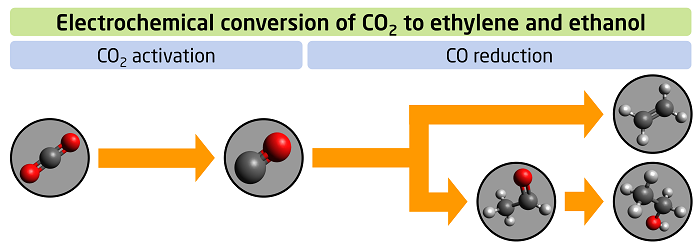Surface functionalization with thiols: a novel STRATegy in CATalyst design for the efficient reduction of CO2 to C2 products
Project period: 2019-2021
Grant: DKK 1.5 mio.
The context
The chemical industry is a key sector in the European economy: today, it generates 1.1% of the European Union’s gross domestic product and ca. 1.15 million direct jobs. It is also the EU’s largest industrial energy consumer and third largest industrial emitter of carbon dioxide.
In its climate action roadmap, the European Commission targets an 80% reduction of greenhouse gas emissions by 2050 (compared to 1990 levels) as well as a nearly exclusive use of low-carbon energy sources in power generation. The chemical industry is a crucial stakeholder for achieving these goals by (1) replacing fossil feedstocks, (2) electrifying its production processes to make use of renewable energy, and (2) providing large-scale solutions for energy storage from intermittent renewable sources. In this context, the Climate Action roadmap sets the stage for nothing less than a fundamental transformation of the European chemical industry.

Combining the electrochemical CO2 reduction reaction (eCO2RR) with increasingly affordable renewable energy sources provides groundbreaking opportunities to use CO2 as a medium for energy storage and as a raw material in chemical production. In particular, ethanol and ethylene are high-value products that can be obtained from the eCO2RR, with wide applications as a fuel and as a building block in the chemical industry. For example, synthetic ethanol from CO2 can be easily integrated in the current transport infrastructure while avoiding the negative effects on food supply and land use associated with bioethanol. On the other hand, ethylene is one of the backbones of the chemical industry its worldwide production is the largest among all organic compounds.
Toward a new breed of electrocatalysts
Several heterogeneous catalysts have demonstrated the potential of adsorbed organic ligands to tune catalytic activity and selectivity. The Lindlar catalyst, widely used in organic synthesis for the hydrogenation of alkynes to alkenes, is perhaps the best-known case. In this palladium-based hybrid material, adsorbed quinoline molecules form a geometric arrangement on the surface that prevents the formation of unwanted oligomers, allowing the catalyst’s high selectivity. In the development of catalysts for CO2 reduction, however, this powerful strategy of using adsorbed modifiers has been mostly neglected.

Aiming to close this knowledge gap, this project has the following objectives:
- To gain a fundamental understanding of how electronic and geometric effects from adsorbed organic molecules modulate selectivity and activity toward C2 products over surface-functionalized electrodes.
- To build on this understanding to develop a catalyst that shows high efficiency in reducing CO2 to ethylene and/or ethanol at industrially relevant current densities in a MEA-type electrolyzer.
This project has received funding from the European Union's Horizon 2020 research and innovation programme under grant agreement 8444288 (STRATCAT-CO2).
Link to description in EU project database: https://cordis.europa.eu/project/id/844288